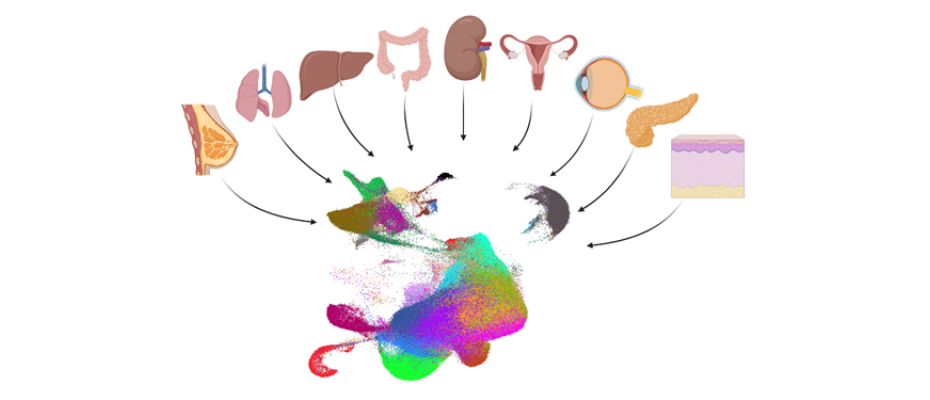
BCN, Dec 14 2021.- Researchers at the Centro Nacional de Análisis Genómico (CNAG-CRG), have created the first cellular atlas of the immune cells infiltrating tumours. The findings are published in a study in the journal Genome Research.
The atlas reveals that different types of tumours in the human body show surprisingly similar patterns of immune cells residing within. Researchers used this knowledge to create a classification system they believe can help predict the immunotherapy response and prognosis of cancer to a level that greatly exceeds current methods.
The researchers tested the atlas’ potential through various tests, showing it can help identify the type of immune cells residing within a patient’s tumour and pinpoint their location. The authors of the study believe this information make the atlas a powerful new complementary tool to personalise cancer treatments for the best possible outcome.
“Current immune-based stratification strategies often require clinicians to look individually at each tumour and visually determine its stage. This offers limited information on the prognosis of a tumour,” explains Paula Nieto, Computational Biotechnologist at the CNAG-CRG and first author of the study. “Our work provides much more detailed information that can help clinicians tailor treatment. While it is an important first step towards precision oncology, we need to carry out more work to test the exact clinical relevance of our proposed clusters.”
The researchers created the atlas by studying the tumour microenvironment. This is the collection of blood cells, immune cells and connective tissue in the immediate vicinity of a tumour, which plays a critical role in the development, progression and control of cancer.
They were particularly interested in the role of immune cells in the tumour microenvironment, as it influences the effectiveness of immunotherapy, treatments that use a person’s immune system to find and destroy cancer cells. Unlike conventional treatments, immunotherapy offers the possibility of long-term remission through boosting the body’s natural defence systems. Despite this benefit, immunotherapy works better for some types of cancer than others and its response rate can be hard to predict.
Being able to assess the types, states and location of immune cells infiltrated within a tumour, also known as its immune profile, could significantly help predict whether a patient benefits from immunotherapy. The authors of the study did this by creating the first cell atlas of immune cells from different types of cancer.
They studied the gene expression of more than 500,000 individual immune cells – selecting 317,111 to analyse – from 217 patients with 13 different types of primary tumours. The analysis revealed that different types of cancer share common immune cell compositions. In total, the researchers identified six different types of immune profiles, each with its own characteristics and potentially different treatment options.
The map’s usefulness was tested in multiple ways. They first took gene expression data from four different types of tumours and compared it their cell atlas. They found this could automatically assign a patient’s tumour to one of the six immune profiles identified within the cell atlas. Doing the same exercise for tumours from mice resulted in the same results, show the cell atlas can also boost cancer research using animal models.
The atlas’ potential to locate the coordinates of immune cells within tumours was also tested. They used a technique called SPOTlight, also developed by the CNAG-CRG, to visualise the gene expression of cells in tumour cross-sections. When combined with the atlas, this revealed the location of “hot” and “cold” regions within a tumour, providing important information on which areas are likely to respond well to immunotherapy.
“This cell atlas of immune cells helps us visualise tumours in ways we have never been able to before,” says Holger Heyn, Leader of the Single Cell Genomics Team at the CNAG-CRG and final author of the study. “Following further research on patient outcome and response to treatment, we expect the atlas to be predictive for patient prognosis and immunotherapy response to a level that greatly exceeds currently applied stratification strategies.”
Work of reference
A single-cell tumor immune atlas for precision oncology
Video
Watch the video where Paula Nieto explains the study
Funding acknowledgements
This publication is part of a project (BCLLATLAS) that has received funding from the European Research Council (ERC) under the European Union’s Horizon 2020 research and innovation pro- gramme (grant agreement No. 810287). This work has received funding from the Ministerio de Ciencia, Innovación y Universidades (SAF2017-89109-P; AEI/FEDER, UE) and the Fundació La Marató de TV3 (201903-30-31-32). We further acknowledge fund- ing from the St. Vincent’s Clinic Foundation (V.T.C.) and the National Health and Medical Research Council Investigator Grant (APP1175781, J.E.P.), the Fundación Asociación Española contra el Cáncer (AECC), FERO (EDM), Ramón Areces Foundation, Cellex Foundation, BBVA (CAIMI), the ISCIII, FIS (PI16/01278), Juan de la Cierva formación fellowship (C.R.-P.) and Sara Borrell fellowship (E.P.R.). Core funding is from the ISCIII and the Generalitat de Ca- talunya. We acknowledge support of the Spanish Ministry of Econ- omy, Industry and Competitiveness (MEIC) to the EMBL partnership, the Centro de Excelencia Severo Ochoa, the CERCA Programme / Generalitat de Catalunya, the Spanish Ministry of Economy, Industry and Competitiveness (MEIC) through the Instituto de Salud Carlos III and the Generalitat de Catalunya through Departament de Salut and Departament d’Empresa i Coneixement. We also acknowledge the cofinancing by the Spanish Ministry of Economy, Industry and Competitiveness (MEIC) with funds from the European Regional Development Fund (ERDF) corresponding to the 2014–2020 Smart Growth Operating Program.











